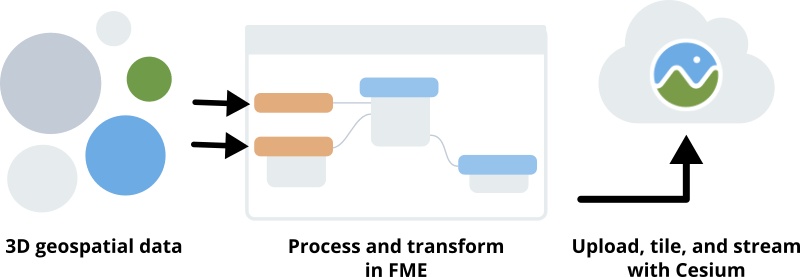Cesium Partnering with Safe Software for FME Data Integration
We aim to make 3D spatial data more accessible and shareable. It’s why we invest so heavily in open standards and interoperability. That’s a vision Safe Software shares. So we’re happy to announce we’re now partnering to make this easier for FME and Cesium users. We’ve been collaborating with Safe Software for a year, and now we’re deepening that relationship as a member of their Technical Alliance Program, expanding what developers can do using FME and Cesium together.

What you can do with the Cesium and Safe FME integration
Almost a year ago we announced the Cesium and Safe FME integration that seamlessly connects Cesium ion to your FME account, allowing you to process and edit your 3D geospatial data with FME and host it with Cesium ion. Today this integration allows you to do much more.
1. Prepare 3D data with FME
With FME, you can take a variety of data types—FME supports more than 400 formats—and transform, combine, and convert data for Cesium. FME’s graphical interface makes it easy to manipulate any geospatial data and to combine multiple datasets to create large-scale 3D models, which can be converted to 3D Tiles or streamed to ion.
2. Stream 3D data as 3D Tiles with Cesium
Once your data is prepared with FME, connect to Cesium ion with the CesiumIonConnector. The Cesium ion integration allows you to securely upload, tile, and host your data with Cesium. Our cloud-based tiling and distributed hosting will optimize your data to stream efficiently as 3D Tiles. The result is that you can share your 3D geospatial data in your custom app, or just in a link.
3. Automate workflows
FME offers the option to create automated workflows with the convenience of their graphical interface. This means you can automatically tile your data into 3D Tiles—virtually hands free—with Cesium ion’s efficient and scalable 3D tiling pipeline.
These automated workflows can be based on a schedule or trigger, such as when new data is uploaded to your server. Automation makes it easy to keep your apps up to date so you can quickly explore and distribute new data.
4. Do more with Cesium’s performance improvements
With the many improvements we’ve added to Cesium ion, including accepting more data formats in our 3D tiling pipeline, adding analysis tools, and improving performance with better compression and faster streaming, you can now share and understand your massive datasets better than ever.
5. Take advantage of FME’s latest enhancements
FME 2019.1 makes data integration workflows easier to build and more powerful to run. In the latest version, you’ll find:
- Automations, a new tool for setting up event-based workflows. Define triggers and actions, monitor directories, merge, filter, and more, all in a visual web interface.
- A new visual preview mode so you can inspect your geospatial data as you build your workflow.
- New transformers for working with rasters, geometry, coordinate systems, and more.
- FME Server enhancements like the ability to share workspaces as apps via a URL, and more control at the admin level.
See what’s new in more detail.
Try it out
To get started, try our tutorial on how to use data and workflows from FME in Ceisum ion, and read Safe Software’s introduction to Visualizing Geospatial Data in a Web Browser with Cesium ion and FME.
We’re excited to keep working with Safe FME to help all our users do more with their 3D geospatial data.